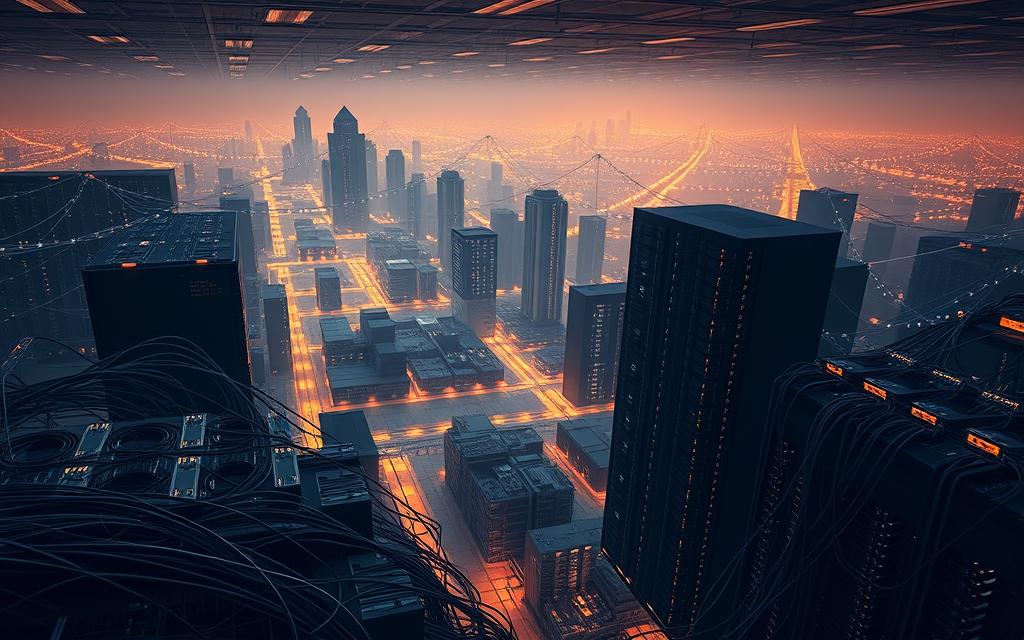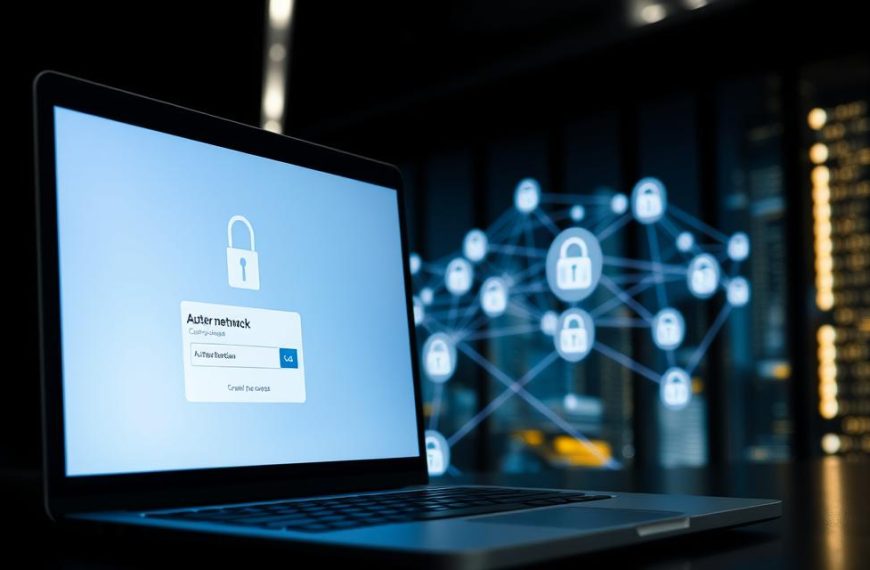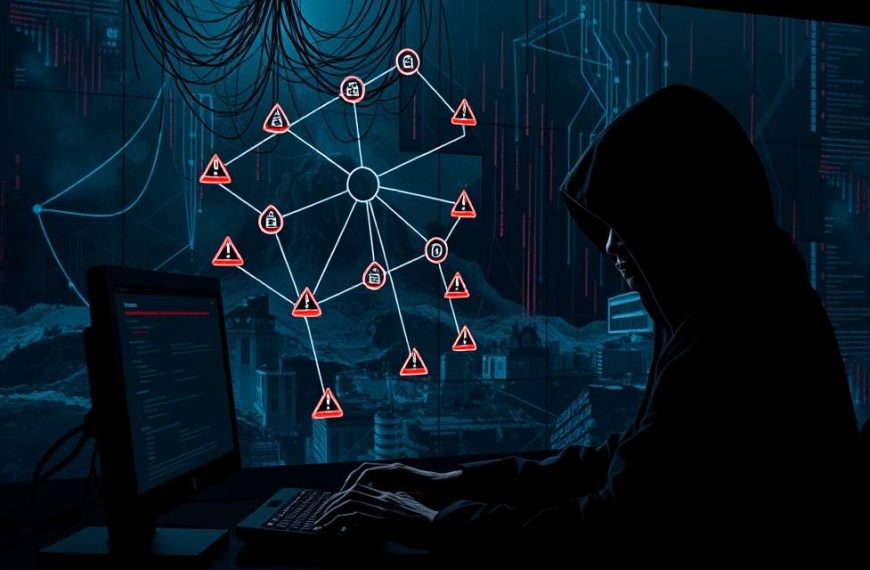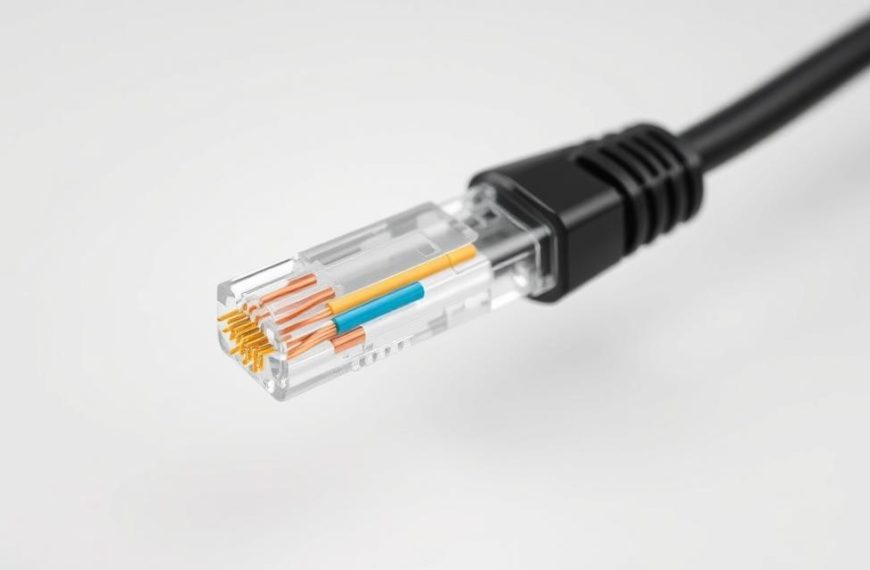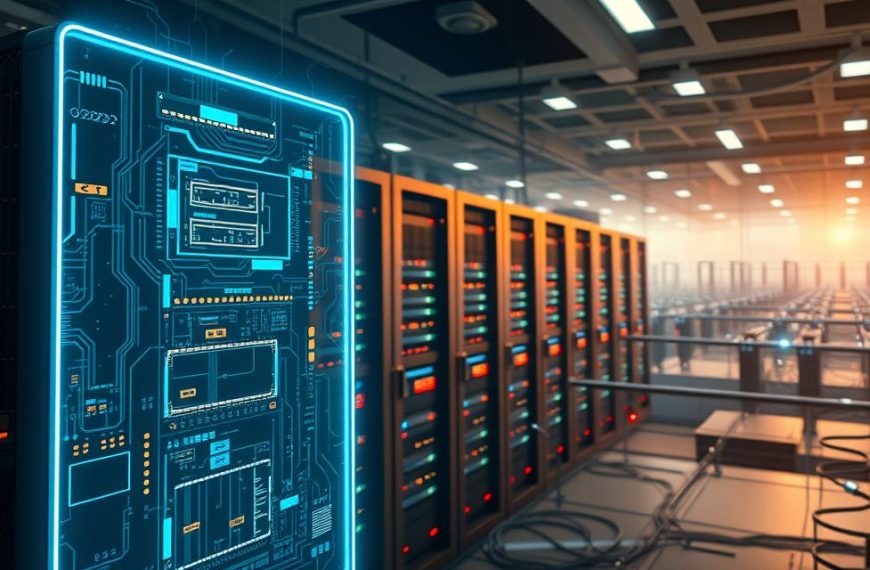The internet connects over 5.3 billion users across continents. It’s a massive global computer network made of submarine cables, satellites, and wireless systems. This mix creates a unique digital world.
Its internet infrastructure uses fibre-optic cables and space technology. This lets people talk in real-time in 7,000 languages and many cultures.
The worldwide web system knows no borders. It reaches from Los Angeles to Kenya, serving everyone. It’s built to handle problems quickly, thanks to its design.
The internet grew from Cold War innovations. Today, it’s fast, with speeds over 1 terabit per second. But few know how it works. Most data travels through underwater cables, while satellites fill gaps.
We’ll look into this amazing network’s structure. We’ll see how it stays reliable, despite challenges. The next parts will show why it’s so big and advanced.
What Makes the Internet the World’s Largest Computer Network?
The internet connects over 29 billion devices worldwide. It’s a huge network that goes beyond just linking computers. It combines technologies, protocols, and physical setups in ways that change how we think about network scale metrics.
Defining Scale in Digital Infrastructure
Comparative Analysis With Other Networks
Enterprise networks like SABRE handle 3 billion requests a year. But the internet moves much more data. Every 48 hours, it handles more data than all air travel bookings from 1960 to now.
Cellular networks cover 95% of populated areas. But they can’t match the internet’s variety. From Antarctic weather stations to IoT in rice paddies, the internet connects everything.
Unique Characteristics Enabling Global Reach
Three things help the internet grow:
- Decentralised architecture for growth
- Standardised protocols for different hardware
- Redundant paths to avoid failures
This lets a Tokyo phone stream video from São Paulo in under a second. It’s fast and reliable.
Key Components Enabling Massive Connectivity
Undersea Cables and Satellite Systems
The internet’s backbone is 436 active transoceanic cabling systems. They stretch 1.2 million kilometres, circling Earth 30 times. Fibre optics carry 99% of international data, with satellites covering remote areas.
This system moves 150 terabits per second. That’s like 75 million Zoom calls at once.
Internet Exchange Points (IXPs)
Critical IXP locations like DE-CIX Frankfurt are key. They connect networks. These data centres:
- Handle 12+ terabits per second at peak
- Reduce latency by keeping data local
- Lower costs through peering agreements
With 400+ major IXPs worldwide, they keep the internet’s map from looking like a chaotic spiderweb.
“The internet isn’t a single network – it’s 70,000 autonomous systems speaking BGP protocol, creating the illusion of seamlessness through technical coordination.”
This complex system of submarine cables, exchange points, and protocols makes the internet unique. As 5G and satellite constellations grow, these network scale metrics will keep changing how we connect globally.
Historical Evolution of Global Networking
The internet started as a secret military project. It became a global tool thanks to teamwork between defence experts and scholars. This story shows how politics and curiosity led to our digital world today.
From ARPANET to World Wide Web
Cold War origins and academic collaborations
In 1969, the US Defence Department launched ARPANET. It connected four nodes, including UCLA and Stanford. This ARPANET development was to keep communication safe during the Cold War. Soon, universities saw its value for sharing resources, leading to new partnerships.
Tim Berners-Lee’s foundational contributions
In 1989, Tim Berners-Lee changed data sharing at CERN. He created the HTTP protocol history and HTML. By 1991, the first website was online, making information more accessible.
Milestones in Internet Expansion
Commercialisation in the 1990s
In 1991, NSFNET was privatised, opening the internet to businesses. AOL and CompuServe started dial-up services. Amazon and eBay led in e-commerce. By 2000, internet users grew from 16 million to 413 million.
Mobile internet revolution
The 2007 iPhone launch changed everything. It made mobile devices internet hubs. Mobile internet use grew from 12% in 2000 to 67% by 2023. Today, 82% of web traffic is video streaming.
Key moments have shaped our internet. Strategic partnerships and innovation have made it what it is. Now, we face new challenges in keeping up with technology.
Anatomy of Internet Infrastructure
The internet connects the world through complex systems. It uses invisible protocols and real hardware. This lets data travel fast across the globe.
Protocols Governing Data Transmission
The TCP/IP layers are at the heart of internet communication. They work like a postal service:
- Application layer (letters)
- Transport layer (postage stamps)
- Internet layer (address labels)
- Network access layer (delivery vans)
TCP/IP Standard Explained
Transmission Control Protocol breaks data into packets. Internet Protocol then routes them. Dr. Ellen Patel says:
“TCP/IP’s genius lies in its error-checking mechanism – it’s why your cat video arrives intact even if 12% of packets get lost en route.”
Role of DNS in Network Navigation
The DNS hierarchy is like the internet’s phonebook. It turns domain names into IP addresses. It handles over 5 billion queries daily through a network of servers.
Physical Network Components
Underneath the digital world is a vast physical network. Almost all international data travels through submarine cables. These cables are thin but carry huge amounts of data.
Fibre Optic Backbone Systems
Fibre optic cables carry data across oceans and mountains. They connect places like Virginia’s “Data Center Alley” to Frankfurt’s DE-CIX exchange point.
5G Towers and Wireless Access Points
5G uses millimetre wave technology for 10Gbps speeds. Towers are placed closely in cities. This supports fast applications like remote surgery.
Data Routing Mechanisms
Smart routing systems keep the internet running smoothly. They make sure your Netflix stream works well, even when it’s busy.
Packet Switching Technology
Packet switching breaks data into small units. They then find the fastest path. This made networks 300% more efficient than before.
Content Delivery Networks (CDNs)
CDNs like Akamai store website copies worldwide. This is why BBC News loads quickly in London. It’s because of local cache nodes.
Global Internet Governance Framework
Managing the world’s biggest computer network needs a mix of technical skills and international talks. A multistakeholder model is used today. It brings together governments, companies, and civil groups. This way, innovation and responsibility are kept in check across 195 countries.
Key Organisations and Their Roles
ICANN’s Domain Management
The Internet Corporation for Assigned Names and Numbers (ICANN) looks after the global domain name system. They run the generic top-level domain (gTLD) programme from California. This model involves many groups working together.
IETF’s Protocol Development
The Internet Engineering Task Force (IETF) builds the internet’s core. They make standards through Request for Comments (RFC) documents. This open process lets engineers worldwide help shape the internet.
| Organisation | Primary Function | Decision Process | Recent Milestone |
|---|---|---|---|
| ICANN | Domain system oversight | Multistakeholder voting | 2023 .web domain launch |
| IETF | Protocol standardisation | Consensus-based RFCs | QUIC protocol adoption |
Challenges in International Regulation
Sovereignty vs Network Neutrality Debates
There are big disagreements over laws like the EU’s GDPR compliance and the US CLOUD Act. These laws affect how data moves between countries. They try to keep user privacy and national security safe.
Cybersecurity Coordination Efforts
Cyberattacks have jumped 46% in 2022, making it hard for countries to work together. There are big gaps in reporting and figuring out who is behind attacks.
Technical groups are under pressure to solve these problems. They must make decisions about the internet’s structure. This is a big challenge in the digital world.
Economic and Social Impact of Global Connectivity
The internet now touches every part of our lives, changing economies and building new cultural bridges. With 5.3 billion users and a digital economy worth $11.5 trillion, it brings both great opportunities and big challenges.
Transforming Business Landscapes
Global networks are key to modern business, with e-commerce making up 19% of retail sales globally. Amazon uses digital economy metrics to improve supply chains. Cloud services from AWS and Azure help manage inventory in real-time across the world.
E-commerce revolution
Online shopping isn’t just about being convenient. It’s creating new economic systems. Last year, cross-border e-commerce grew 12%, thanks to:
- Secure payment gateways
- AI-driven customer insights
- Blockchain-powered logistics
Remote work infrastructure
Zoom infrastructure shows how video calls have grown from simple apps to big business tools. They support 300 million users daily. This change saves US companies $30 billion a year but raises questions about:
- Data security in distributed teams
- Work-life balance standards
- Cloud service reliability
Cultural Exchange and Digital Globalisation
Social platforms are like virtual town squares where memes spread fast. TikTok’s AI adapts content for 75 languages but sometimes misses cultural subtleties.
Social media’s role in connectivity
Platforms connect people in ways diplomats can’t. 63% of Gen Z users have made international friends online. But this connection also brings:
- New forms of digital activism
- Cross-border misinformation risks
- Algorithmic bias challenges
Language localisation challenges
While Unicode adoption standardises text, tech firms face:
- Emoji interpretation differences
- Right-to-left script integration
- AI translation accuracy gaps
A study found 41% of users leave apps that aren’t localised properly. This costs developers $8.7 billion a year.
Emerging Challenges for the Global Network
The internet is growing fast, facing new challenges that test its core. Network engineers and cybersecurity experts are focusing on two main areas.
Scalability and Bandwidth Demands
More devices are connecting, putting pressure on networks. By 2025, 75.4 billion IoT devices will need IPv6 addresses. This means almost 10 smart gadgets for every person on Earth.
This growth brings IoT security risks. Many devices come with default passwords and old firmware.
Watching videos in 8K is also a challenge. A single 8K video stream needs 48Mbps bandwidth. This is a lot for home internet during busy times.
Telecom companies are working hard to meet these 8K bandwidth requirements. They’re setting up fibre-optic networks. Now, 400G optical links are the new standard.
“The shift to ultra-HD content isn’t gradual – it’s a tidal wave reshaping network economics.”
Security Threats in Interconnected Systems
Cybercriminals are using the network’s strengths against it. In 2023, a 71 million requests-per-second DDoS attack hit European banks. These attacks use IoT devices as tools, creating botnets that can harm entire sectors.
Cross-Border Cybercrime Challenges
Law enforcement faces challenges due to different laws in countries. INTERPOL’s Global Cybercrime Programme tracks 192 cybercrime groups in 86 countries. They’re using AI to detect threats in 14 languages.
Important security steps include:
- Real-time traffic analysis for DDoS pattern recognition
- Blockchain-based device authentication protocols
- Cross-border digital evidence sharing frameworks
Conclusion
The internet has grown from 56k modems to global computer networks supporting 800Gbps Ethernet. This shows our huge technological ambition. It now supports our daily lives, allowing us to talk in real-time across the world and powering huge economies.
Looking ahead, we need to innovate even more. 6G aims for terabit-speed wireless, and quantum networking could change how we keep data safe. These changes could change how businesses work and how governments keep us safe.
We face new challenges that need bold answers. New cryptography standards are being made to fight cyber threats. AI might soon help manage internet traffic better. These steps are key as more people use the internet than ever before.
Our journey shows we can work together to advance technology. From Bell Labs to today’s fibre-optic cables, each step has opened new doors. As we move towards quantum computing and always-connected devices, the internet’s impact on us is clear.

